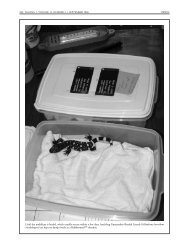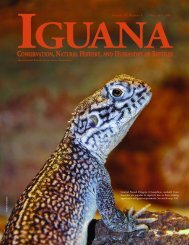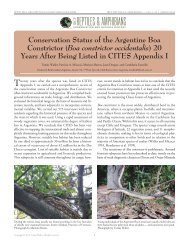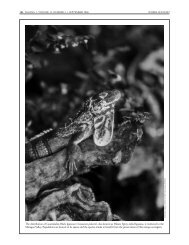Spiny-tailed Iguanas (Ctenosaura similis) in Venezuela
Spiny-tailed Iguanas (Ctenosaura similis) in Venezuela
Spiny-tailed Iguanas (Ctenosaura similis) in Venezuela
Create successful ePaper yourself
Turn your PDF publications into a flip-book with our unique Google optimized e-Paper software.
COMMENTARIES<br />
Sometimes I wonder whether I have chosen the wrong profession.<br />
How many English professors, after all, have a 6foot-long<br />
reproduction of Rudolph Zall<strong>in</strong>ger’s “The Age of<br />
Reptiles” mural from Yale’s Peabody Museum hang<strong>in</strong>g <strong>in</strong> their<br />
home office above cab<strong>in</strong>ets full of fossils, butterflies, and<br />
seashells? As a child, I was, like many kids, fasc<strong>in</strong>ated by<br />
d<strong>in</strong>osaurs. One of my most powerful early memories is of visit<strong>in</strong>g<br />
the great hall of Philadelphia’s Academy of Natural Sciences:<br />
an enormous 19th-century gallery decorated, as I recall, with<br />
wrought iron, entablatures, oak, and marble. I remember my<br />
footsteps echo<strong>in</strong>g as I walked toward the polished rail<strong>in</strong>g beh<strong>in</strong>d<br />
which stood the Hadrosaurus, more than 20 feet tall and impossibly<br />
ancient. The mounted skeleton — brown, lacquered, and<br />
crackled, like a Rembrandt pa<strong>in</strong>t<strong>in</strong>g — revealed itself gradually<br />
as my eyes adjusted to the light. D<strong>in</strong>osaur Hall was a temple<br />
dedicated to the wonder of creation, the aspirations of science,<br />
and the smallness of humanity <strong>in</strong> the context of geologic time.<br />
I kept that faith, earn<strong>in</strong>g top grades <strong>in</strong> science courses, until<br />
my junior year of high school, when the rigors of trigonometry<br />
and physics — the empirical fetish — more or less put an end<br />
to my scientific ambitions, if not to my love of science. It surprises<br />
some people when I say that the closest cous<strong>in</strong> to science,<br />
for me, was English, because it, too, was about the cultivation<br />
of wonder and imag<strong>in</strong>ation.<br />
Nowadays, when a scholarly conference br<strong>in</strong>gs me to<br />
Philadelphia, New York, Chicago, or Wash<strong>in</strong>gton, I try to make<br />
a trip to their natural-history museums. But I rarely f<strong>in</strong>d what I<br />
am look<strong>in</strong>g for. I suppose I am try<strong>in</strong>g to relive my childhood. I<br />
know the past is easy to glorify, but I do not th<strong>in</strong>k my disappo<strong>in</strong>tment<br />
comes only from my tendency toward nostalgia and<br />
old-fogeyism. I th<strong>in</strong>k natural-history museums have changed for<br />
the worse <strong>in</strong> the last 30 years. The solitude, silence, and quasireligious<br />
awe that I remember have been banished by throngs of<br />
scream<strong>in</strong>g, barely supervised children on school trips, who pay<br />
less attention to the exhibits than they do to the gift shops and<br />
food courts. No doubt, the museums were forced <strong>in</strong>to that situation<br />
by economic necessity and political demands that they<br />
cater to the broadest possible segment of the public. That means<br />
museums simplify their exhibitions rather than expect visitors to<br />
aspire to a higher level of appreciation for someth<strong>in</strong>g outside the<br />
normal range of experience.<br />
I remember, even as a 10-year-old, not lik<strong>in</strong>g the new children’s<br />
annexes that were first <strong>in</strong>stalled back <strong>in</strong> the 70s. I felt a lit-<br />
IGUANA • VOLUME 15, NUMBER 3 • SEPTEMBER 2008 175<br />
The Decl<strong>in</strong>e of the<br />
Natural-History Museum 1<br />
1 Copyright © 2008, The Chronicle of Higher Education. Repr<strong>in</strong>ted<br />
with permission.<br />
2 Thomas H. Benton is the pseudonym of an associate professor of<br />
English at a Midwestern liberal-arts college. He writes about academic<br />
culture and welcomes reader mail directed to his attention<br />
at careers@chronicle.com.<br />
Thomas H. Benton 2<br />
tle <strong>in</strong>sulted, as if I was be<strong>in</strong>g made to watch Sesame Street, or<br />
spend time <strong>in</strong> a day-care center. Clearly, these “Please Touch”<br />
museums have to cater to a wide age range, but, just as it often<br />
does <strong>in</strong> the classroom, that seems to mean aim<strong>in</strong>g at an everlower<strong>in</strong>g<br />
median of knowledge, <strong>in</strong>terest, and common civility.<br />
My 7-year-old daughter also loves natural history. She likes<br />
be<strong>in</strong>g able to handle real fossils and touch exotic animals, but<br />
she does not like be<strong>in</strong>g crowded and trampled by other children<br />
who often reduce museums to someth<strong>in</strong>g approximat<strong>in</strong>g life <strong>in</strong><br />
the Hobbesian state of nature. So we have learned to avoid the<br />
so-called children’s sections, even though the behavior they<br />
encourage seems to have spilled out to the rest of the museum.<br />
Unfortunately, the Academy of Natural Sciences was a victim<br />
of the imperialism of the juvenile back <strong>in</strong> the mid-80s.<br />
D<strong>in</strong>osaur Hall, no longer a chapel, is now brightly lit and<br />
pa<strong>in</strong>ted <strong>in</strong> “kid-friendly” colors. The architectural details are<br />
concealed beneath wall-to-wall carpet<strong>in</strong>g and plaster board.<br />
The Barosaurus at the American Museum of Natural History, rear<strong>in</strong>g<br />
up and defend<strong>in</strong>g its young from an advanc<strong>in</strong>g Allosaurus, is perhaps<br />
the greatest mounted d<strong>in</strong>osaur exhibit <strong>in</strong> the world.








